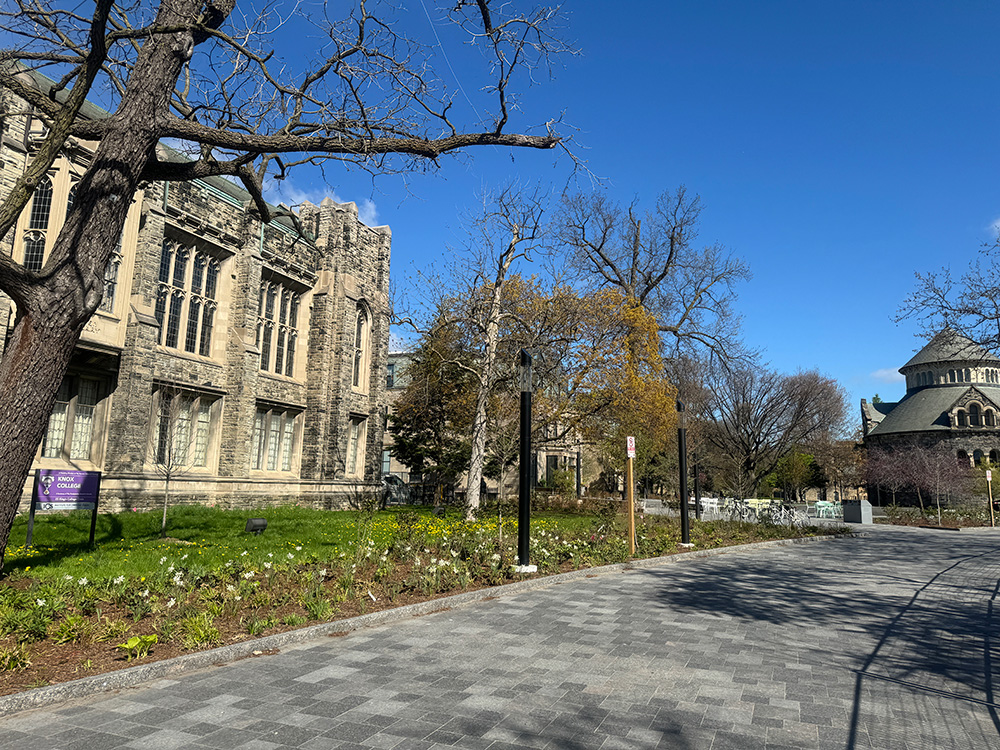Information Technology Services (ITS)
Wi-Fi comes to Landmark: Connecting the University of Toronto outdoors
Published on: November 22, 2024
Spanning the area around Front Campus and King’s College Circle—including the underground Landmark Parking Garage—this recent wireless network rollout is part of a larger, tri-campus initiative to continually upgrade and expand Wi-Fi coverage across the University’s three campuses.
“The buildout and refresh of U of T’s wireless network is an ongoing project,” says Douglas Carson, Senior Manager, Enterprise Networking, Information Technology Services. “I often liken it to painting the Golden Gate Bridge: we start at one end, and by the time we’re finished, we need to start all over again. And every so often we change the colour—that is, we start installing the next generation of wireless technology—midway through the job.”

While the scope of the outdoor Landmark deployment is relatively compact in comparison with what would be typically installed in a building, having a total of nine field-level and nine parking-level access points, the area covered is quite large—just under 4 hectares—and the installation of outdoor Wi-Fi presents some unique challenges.
To work reliably in the harsh outdoor environment, the team had to be creative in the selection, design and installation of the equipment, which included outdoor cabling, special AP models and hardened network equipment to withstand hot humid summer and subzero winter temperatures.
The team also had to contend with the potential for vandalism and theft, both of which can be more prevalent in outdoor locations. Their solution? Housing the APs within elegant, energy-efficient, and durable Exelia LED Column light poles. The poles not only protect the equipment but also provide lighting for pedestrian pathways while ensuring that the wireless installation does not detract from the aesthetics of the campus.
Carson credits Richard Cheng, the engineer responsible for the wireless infrastructure designs across the St. George campus, for his leadership on this and related projects.
“Richard worked extensively with the architects, lighting standard manufacturer, U of T ’s project management team, our equipment supplier, and the contractor to address the many issues that arose during this project,” says Carson.
But while outdoor network installations present challenges, they also come with rewards.
Front Campus is not only a favourite hangout for students and one of the most picturesque parts of downtown Toronto, it’s also used for major campus events such as Convocation. The newly-installed network was thoroughly tested during this fall’s Convocation event, marking the first time the university was able to offer Wi-Fi coverage to the whole Front Campus.
The Landmark Project itself, named for the landmark buildings that surround the space, is part of a comprehensive plan to make U of T a more connected and accessible campus—both physically and digitally—in line with modern student and faculty needs.
The Landmark rollout is a significant milestone, but it’s by no means the first outdoor Wi-Fi project at the university. Eleven other locations also benefit from outdoor wireless coverage, including the exteriors of University College, Innis College and Massey College, and well as various patio and rooftop locations. As the wireless network continues to expand, additional outdoor locations will be added.
The Landmark outdoor Wi-Fi project is nearly complete—aside from a few minor issues with poles and cabling—and the new network has already made a noticeable impact on campus life.
“I’m very pleased to see this aspect of the amazing Landmark Project come together,” says Patrick Hopewell, Director, Enterprise Infrastructure Solutions, ITS. “Thanks to the dedicated work of our network engineers, designers and project managers, all members of the University community will be able to stay connected while they enjoy the beautiful surroundings in and around King’s College Circle.”
The addition of outdoor Wi-Fi at Landmark and surrounding spaces is an important step in U of T’s ongoing efforts to provide an accessible, connected experience for its community—both inside and outside the classroom. As the University continues to expand its wireless network, students and faculty can stay connected to the resources they need, no matter where they are on campus.

